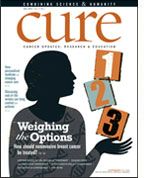Publication
Article
CURE
Meeting Dr. Brodie
Author(s):
The goods on good medicine.
In April, my guest blog post, “Good Medicine,” was featured on curemagazine.com. It began with my response to women who complain about broken nails and parking tickets:
“Let me get this straight,” I say, pointing at my chest where two perfectly formed breasts used to reside pre-double mastectomy. “I’m flat as a pancake, have chemobrain until noon, and my eyebrows never grew back, but do you hear me complaining?”
“We don’t know how you do it,” they sigh, shaking their heads with a mixture of pity and ... well, pity. This is what kills me. That “civilians” ... act like cancer survivors have a real choice in the matter. Like choosing the paint color for our car from the factory.
“Chutzpah!” I declare with a winning smile,“That’s how I do it, chutzpah and good medicine …”
The “good medicine” I referred to is an aromatase inhibitor, a drug that neutralizes estrogen for those with estrogen-positive breast cancer, the most common form of the disease. After the blog was published, I was determined to find the person who developed it. I was convinced that it saved my life and the lives of millions of women.
This was easier said than done. Especially when, from my observation, pharmaceutical companies, not people, take most of the credit.
After much digging, I found an article about Angela Brodie, a University of Maryland pharmacologist, who developed the drug in the 1970s. American pharmaceutical companies took little interest in her drug until 1981, when a British oncologist gave the compound to his patients and saw an immediate response. The rest is history. Pharmaceutical companies came knocking and aromatase inhibitors became widely available in 1998.
A Google search revealed to me that Brodie, 80 years young, was still in the trenches of cancer research at the University of Maryland. Heart racing, I emailed her a copy of “Good Medicine,” with a note saying how grateful I was for her work.
But I found that, like an organ recipient who wants to meet the family of the donor, I felt the urge to meet her personally.
She responded the very next day. “Good Medicine,” she told me, was pure poetry. Having lost so many friends to the disease in her lifetime, she felt it was a reaffirmation of her life’s work. She would enjoy meeting me and taking me on a tour of the lab.
In May, my husband and I drove 500 miles to Baltimore for what would be a highlight of my life, post-cancer. Brodie was humble and gracious, more interested in my cancer journey than in recounting her distinguished career in pharmacology. During the tour, she introduced us to her assistants, who were young, bright, gregarious and obviously loved their work with her. One of them, who was maybe 26 years old, said, “Cool! We haven’t met a real patient for, like, five years.” I thought, “Wow! What a moment.” Brodie told them, “Carolyn wrote the essay, ‘Good Medicine,’ that I showed you.” Their excitement only grew. “Oh, my God, that was such a great piece! It made us laugh and cry and feel good about our work.”
Thank you, Angela Brodie, for giving me the best years of my life.
—Carolyn Choate received a diagnosis of stage 3B ER-positive breast cancer 11 years ago at age 45. Choate, a television writer who lives in Nashua, N.H., continues taking the aromatase inhibitor letrozole under the care of her oncologist. Share your story! Whether you are a patient, survivor, caregiver or healthcare provider, we want to read your unpubished (must not have appeared in print or online) stories about cancer and the people, places and moments of the experience. They can be funny, poignant or practical. Send them to editor@curetoday.com. Stories should be no more than 600 words and include your name, phone number and email. We look forward to hearing from you!






